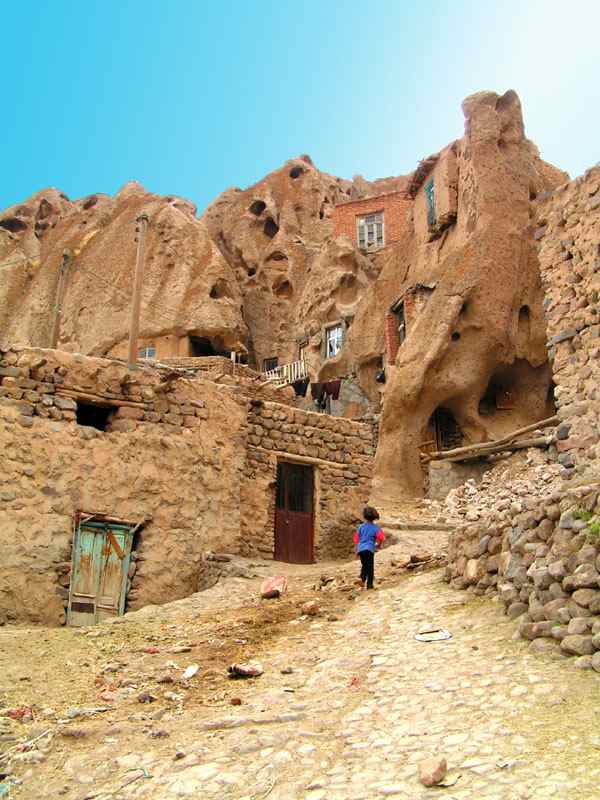 Kandovan Village
Kandovan Village
Kandovan is an ancient village tucked away in the northwest corner of Iran at the foothills of Mount Sahand and near the city of Tabriz.
Geology of Kandovan Village
The rock that makes up the cones in Kandovan Village is made up of a volcanic deposit called 'tuff' (pronounced 'toof' by the British and 'tough' by Americans). The deposit consists of igneous rock that is soft and which can be worked without the use of hard metal tools. (Igneous mean formerly molten - made with fire.) The rock was spewed out an explosive eruption of the Sahand volcano as airborne debris called tephra. The explosive eruption was probably caused by high pressure steam which would likely cause steam and other gas pockets (that would later become air pockets) when the molten material rapidly solidified. Rock with air or gas cells is called pumice. Pumice can be light enough that it floats on water. It can also be a good heat insulator. The deposited tephra that formed Kandovan's rock cones consisted of stone-sized debris and ash. You can see the composition if you look closely at the surface of the caves or the cones.
Use of Caves as Human Dwellings
As we have noted previously, in the area of Kandovan, Sahand's volcanic ash and debris was fused and shaped by natural forces into cone-shaped pillars containing pockets that became caves. The hardened material of the cones is strong enough to function as walls and floors of a house and yet soft enough to allow a further shaping of the caves. The material is also an efficient insulator and the troglodyte's homes have the reputation of being very energy efficient, remaining cool in summer and warm in winter. The cave homes require minimal supplemental heat during the long cold season, making for comfortable year round habitation.
Most of the cave houses are two to four storey’s in height. In a typical four storey house, the ground or first floor is used as an animal shelter, the next two floors are used as living areas, and the top floor is used for storage. There are reports of tunnels connecting towers owned by a person or family.
Kandovan's Age
The present residents say that their village is around 700 years old, and was formed by people fleeing from an advancing Mongol army and who used the caves as a refugee and a place of hiding. Even after the Mongol occupation of the country came to an end, many of the refugees decided to continue living in the caves and gradually expanded their cave homes to form permanent multi-storey houses. Another legend states that eight hundred years ago a body of soldiers hid in the caves during a military campaign.
However, there are indications that the caves of Kandovan were inhabited as far back as 3000 years ago - around the time when the Zoroastrian Medes and Persians inhabited the region
(heritageinstitute.com)
The two villages of Kandovan (northwest Iran) and Meymand (southeast Iran) comprise houses cut into the volcanic rocks. Kandovan is located at the foot of Mount Sahand, where the shelters have been dug out of hardened ashes or lahar beds (Figure 5.2).The houses have been carved into the steep slopes of the mountain and are now supplied by electricity, running water and a wastewater system. Some have two stories with staircases inside, and all are still inhabited. Meymand village is located at the foot of Mt Mozahem, and it is approximately 2000 years old. Here the house walls are built of volcanic conglomerate and hardened ashes. The carved structures include a mosque (which is the largest opening), a school, a public bath, and a structure that seems to have been used as a fire temple. The Meymand Village differs from that of Kandovan; the area is not so steep, and also the houses are no longer inhabited.
Alireza Amrikazemi & Abbas Mehrpooya
Ross Dowling, David Newsome (2006). Geotourism, Publishe by Elsevier, PP 83- 84.